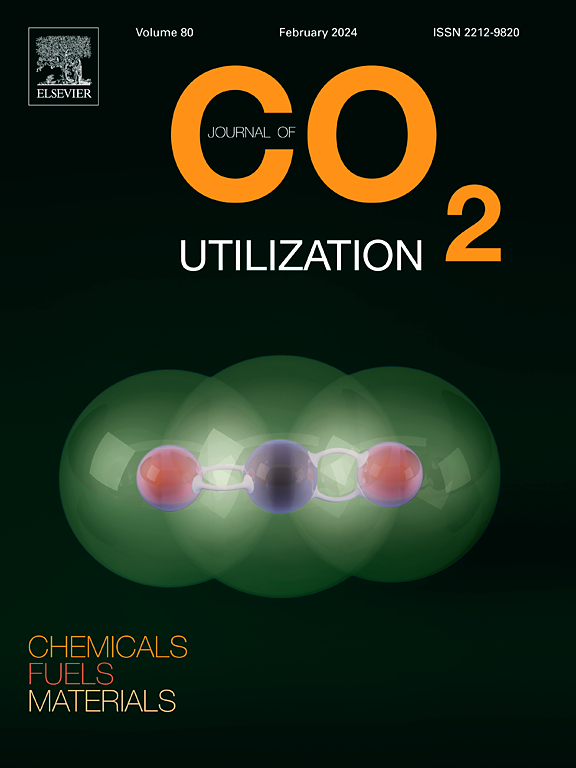温和的生物质气化作为碳中性的二氧化碳利用过程
IF 8.4
2区 工程技术
Q1 CHEMISTRY, MULTIDISCIPLINARY
引用次数: 0
摘要
将二氧化碳作为可再生生物质原料的气化剂代表了一种二氧化碳利用(CDU)的创新方法,可以实现碳中和。在600℃的低气化温度下也观察到这种效应。当在气化剂与氩气的混合物中以58.5% %v的浓度供应时,二氧化碳在产生的反应中被消耗,并用于气化木炭,同时产生多余的合成气CO。这表明在温和的温度下,以浓度为基础驱动二氧化碳利用反应是可能的,但在这些条件下,净二氧化碳转化率被限制在0.434 %。热解后的炭还原阶段转化率最高,说明转化的主要途径是逆Boudouard反应。与可比热解实验相比,温和温度下CO2气化产生的CO多出0.80 mmol/g,而碳-碳的生成少0.353 mmol/g,进一步证明了在此条件下逆Boudouard CO2-炭转化机制是活跃的。二氧化碳气化剂似乎不会改变热解脱挥发过程的开始,尽管在热解过程中,当炭形成时,观察到少量的炭-二氧化碳相互作用。与惰性气氛下热解相比,CO2气氛下脱挥发的CH4产率增加了2.642 mmol/g。这些结果在气化炉和系统设计参数的背景下进一步讨论,这些参数最大限度地提高了综合生物质发电和BECCS(具有碳捕获和储存的生物能源)循环的热效率。本文章由计算机程序翻译,如有差异,请以英文原文为准。
Mild-temperature gasification of biomass as a carbon-neutral CO2 utilisation process
Applying CO2 as a gasifying agent for renewable biomass feedstocks represents an innovative method of carbon dioxide utilisation (CDU) that could be carbon neutral. This effect has now been observed under low gasification temperatures of 600℃. When supplied at concentrations of 58.5 %v in a gasifying agent mixture with argon, CO2 was consumed in the resulting reaction and used to gasify char while producing excess syngas CO. This indicates a concentration-based push to drive CO2 utilisation reactions is possible at mild-temperatures, but net-CO2 conversion was limited to 0.434 % under these conditions. Conversion was highest during the period of char reduction following pyrolysis, indicating the principal route of conversion is the reverse Boudouard reaction. Mild-temperature CO2 gasification yielded an excess of 0.80 mmol/g of CO while generating 0.353 mmol/g less char-carbon than comparable pyrolysis experiments, further demonstrating the reverse Boudouard CO2-char conversion mechanism is active under these conditions. The CO2 gasifying agent does not appear to change the onset of pyrolytic devolatilization processes, although minor char-CO2 interactions are observed during pyrolysis as char is formed. Additionally, the CO2 atmosphere yielded 2.642 mmol/g more CH4 during devolatilization compared to pyrolysis under an inert atmosphere. These results are further discussed in the context of gasifier and system design parameters that maximise the thermal efficiency of integrated biomass power and BECCS (bioenergy with carbon capture and storage) cycles.
求助全文
通过发布文献求助,成功后即可免费获取论文全文。
去求助
来源期刊

Journal of CO2 Utilization
CHEMISTRY, MULTIDISCIPLINARY-ENGINEERING, CHEMICAL
CiteScore
13.90
自引率
10.40%
发文量
406
审稿时长
2.8 months
期刊介绍:
The Journal of CO2 Utilization offers a single, multi-disciplinary, scholarly platform for the exchange of novel research in the field of CO2 re-use for scientists and engineers in chemicals, fuels and materials.
The emphasis is on the dissemination of leading-edge research from basic science to the development of new processes, technologies and applications.
The Journal of CO2 Utilization publishes original peer-reviewed research papers, reviews, and short communications, including experimental and theoretical work, and analytical models and simulations.
 求助内容:
求助内容: 应助结果提醒方式:
应助结果提醒方式:


